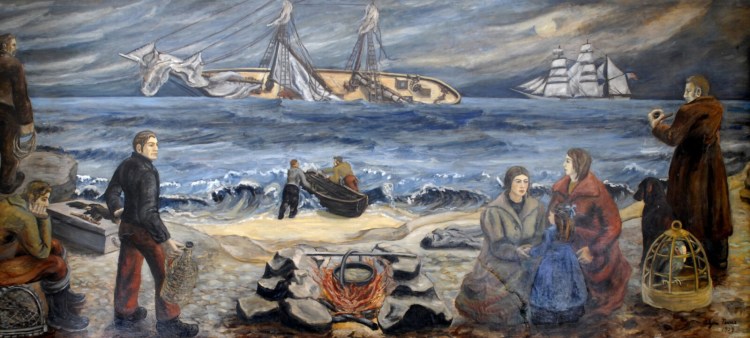Feb. 22, 1864: The three-masted steamer Bohemian, bound from Liverpool, England, to Portland, strikes Alden’s Rock, a ledge near Cape Elizabeth, at night in a dense haze. The accident kills 42 people, including two crew members.

The ship, an iron vessel owned by the Ocean Steamship Co. of Montreal, was carrying 219 passengers, most of them Irish immigrants traveling in steerage class; and 99 crew members. It left Liverpool on Feb. 4.
In that era, Portland is the winter port for passengers and freight heading to and from Montreal because the St. Lawrence River is too choked with ice for about five months a year to allow ships to pass.
When the Bohemian’s captain, Richard Borland, sees Cape Elizabeth through the haze on the night of the accident, he thinks he is farther at sea than he really is. The impact with the ledge tears a hole in the engine room, damaging it severely.
The crew sends up flares to summon a pilot boat, but they can’t be seen through the haze. Borland orders the ship’s two guns to be used as a distress signal. The first one fires, but the second already is underwater. Two men in a pilot boat hear the lone shot. They wait for another, and hearing none, they assume someone has fired at random during an impromptu celebration of George Washington’s birthday.
The Bohemian is equipped with six lifeboats that might be sufficient to evacuate everyone safely. The first is launched without incident, carrying about 80 people. A pin holding the second boat breaks, and many passengers are heaved into the ocean. About 16 men, women and children are killed.
The other boats are released, but they are not full. Many people jump into the ocean from the steamer and drown. Borland, the boatswain, three other crew members and 70 to 80 passengers remain on the ship. Most of them climb onto the foretop or into the rigging. Those who don’t are swept out to sea when the ship settles in water 24 to 30 feet deep.
Lifeboats return to pick up the people still clinging to the parts of the ship still poking above the ocean’s surface. Cape Elizabeth residents open their homes to shelter the survivors. Later, scavengers pilfer cargo from the half-sunken wreck.
A coroner’s jury blames the accident on Borland’s bad judgment, the lack of a bell on Alden’s Rock and inattentiveness of the men in the pilot boat. Unclaimed bodies are buried in a mass grave in South Portland.
A mural named “Shipwreck at Night” now graces a wall at the South Portland post office as a tribute to the disaster victims.
Feb. 22, 1878: Bank cashier John Wilson Barron is fatally attacked during a robbery at a bank in the Penobscot County town of Dexter. The robbers apparently expected nobody to be there because it was Washington’s Birthday, a national holiday.
The crime is discovered when Barron’s wife reports him missing that evening. Barron, handcuffed and gagged, is found alive in the bank vault but dies the next morning. Bank robberies being a common occurrence in an age when Maine is experiencing a booming lumber trade, authorities question the usual suspects and offer handsome rewards for information leading to the killers. They get no results.
Ten years later, the case draws national attention when suspects David Stain and Oliver Cromwell, both of Medfield, Massachusetts, are arrested and put on trial in Bangor. East Coast newspapers cover the proceedings as relentlessly as the news media of the 1990s scrutinized the murder trial of actor and ex-professional football player O.J. Simpson. The defendants are tried, convicted and sent to the Maine State Prison in Thomaston.
The verdict is appealed to Judge John Peters, who presided at the trial. He rejects the appeal. A subsequent appeal to the Maine Supreme Judicial Court – of which Peters is the chief justice – also fails. While awaiting that final decision, the chief defense lawyer, Lewis Amasa Barker, 35, of Bangor, dies of illness and fatigue exacerbated by his defense work on the prisoners’ behalf.
After several more years, a key witness – Stain’s son – recants, admitting having fabricated a story about his father’s participation in the robbery because he was angry with him. Gov. Llewellyn Powers and his council consider the matter in response to a petition from Barker’s son, Lewis Appleton Barker, who represents the prisoners after being admitted to the bar only months earlier. On Dec. 31, 1900, two days before Powers leaves office, the governor and council agree unanimously to pardon Stain and Cromwell.
The two prisoners are freed, and the murder case remains unsolved to this day.
Joseph Owen is a retired copy desk chief of the Morning Sentinel and Kennebec Journal and board member of the Kennebec Historical Society. He can be contacted at: jowen@mainetoday.com.
Send questions/comments to the editors.



Comments are no longer available on this story